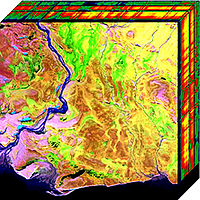
Photo from wikipedia
BACKGROUND Thermal ablation is the dominant modality to treat liver tumors for discriminating patients who are not allowed to have surgical intervention. Conversely observing or foreseeing the size of the… Click to show full abstract
BACKGROUND Thermal ablation is the dominant modality to treat liver tumors for discriminating patients who are not allowed to have surgical intervention. Conversely observing or foreseeing the size of the subsequent tissue putrefaction during the Thermal Ablation techniques is a difficult undertaking. OBJECTIVE To examine the impacts of ablation zone volume following Radiofrequency ablation (RFA) of an ex-vivo bovine liver to correlate the impacts of thermal ablation with target organ perfusion; by exploiting the unique properties of Hyperspectral Imaging (HSI). MATERIALS AND METHODS Radiofrequency ablation was perfused on ex-vivo bovine livers at peripheral and central‑vessel‑adjacent locations, and monitored by HSI with a spectral range from 400 to 1000 nm. The system contains k-means clustering (K = 8) algorithms combining spectral and spatial information. Labeled spectral signatures datasets were used as training data. Statistical analysis (10 samples) was computed to calculate the highest variance between six spectral images for determining the optimum wavelength for discrimination between the affected regions after thermal ablation (normal, thermal, and ablated liver tissue regions). RESULTS The change of the optical properties ofex-vivo liver tissues provides different responses to light transmission, scattering, absorption and particularly the reflection over the spectrum range. The produced spectral image from reflection with the highest variance (358.07) empowered us to determine the optimum wavelength spectral image (720 ± 18.92 nm) to distinguish between the normal, ablated, and thermal categories. CONCLUSION Hyperspectral imaging is a powerful tool in monitoring tissue characterization, which is useful technique for edge evaluation of liver thermal ablation to enhance the surgical outcome.
Journal Title: Photodiagnosis and photodynamic therapy
Year Published: 2020
Link to full text (if available)
Share on Social Media: Sign Up to like & get
recommendations!